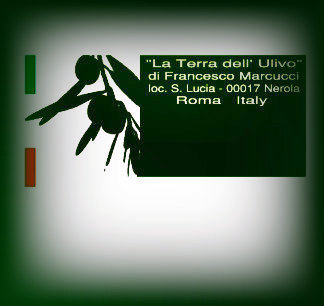"La Terra dell’Ulivo” is a farm which extends over 15 ha on the hills (350 - 400 metres above sea level) in the heart of Latium’s Sabina, distributed among the municipalities of Nerola, Montorio Romano (Rome) and Scandriglia (Rieti). The olive groves cover 7 ha of the property, counting 1300 trees whose age ranges from 10 to 80 years, belonging to different typical varieties such as Frantoio, Leccino, Moraiolo and Carboncella. The whole production process of olive oil is performed with the utmost care during each one of its phases: manual harvesting, immediate pressing of the yields (4/6 hours up to a maximum of 12 hours later) processing the olives at a temperature of 25°-26°C, in order to keep the characteristics of the drupe unaltered.
The extra-virgin olive oil produced in the farm, even if not certified, strictly follows the regulations of biological agriculture and the firmly established dictates of the biodynamic agriculture, in the respect of the environment and of the natural biological cycles, in the aim of keeping the high quality of its product.
Two years ago the owner of the farm, Mr Francesco Marcucci, joined the Biolabel Project “Digital Seal” (link), a program of quality certification created to help purchasers to trace the provenance and the bio-based quality of the products. The producers participating in the project apply a new generation bar code label on each bottle which permits the easy traceability of the producer and the area of production thanks to a simple photo taken by a smartphone.
The subscription to the Biolabel Project implies the strict respect of a protocol of ethical behaviour provisions, also regarding the olive oil processing according to high quality standards, as well as the geographical location of the production area accurately detailed with its complete Land Registry data.
From a scientific point of view, the Biolabel Project provides for the intervention of two Institutes of Research. The first one submits the product to MRI (Magnetic Resonance Imaging) which permits to establish the age of the product and the characteristics of its geographic area, while the second analysis, more traditionally takes into consideration its organoleptic properties, such as acidity and polyphenol content.







